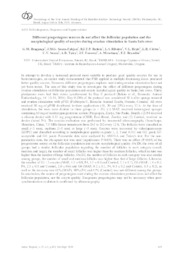Different progestagens sources do not affect the follicular population and the morphological quality of oocytes during ovarian stimulation in Santa Inês ewes.
Different progestagens sources do not affect the follicular population and the morphological quality of oocytes during ovarian stimulation in Santa Inês ewes.
Author(s): BRAGANÇA, G. M.; SOUZA-FABJAN, J. M. G.; BATISTA, R. I. T. P.; RIBEIRO, L. S.; BRAIR, V. L.; CÔRTES, L. R.; SOUZA, C. V.; TRAIRA, A. R.; FONSECA, J. F. da; MENCHACA, A.; BRANDÃO, F. Z.
Summary: In attempt to develop a hormonal protocol more suitable to produce good quality oocytes for use in biotechnologies, an earlier study demonstrated that FSH applied in multiple decreasing doses produced better quality oocytes. However, different progestagens implants used during ovarian stimulation have not yet been tested. The aim of this study was to investigate the effect of different progestagens during ovarian stimulation on follicular population and oocyte morphological quality in Santa Inês ewes. In conclusion, the source of progestagens used during the ovarian stimulation protocol does not affect the follicular population, nor the oocyte quality. Exogenous progestagens may not be necessary when postsynchronization ovulation is confirmed by ultrasonography.
Publication year: 2018
Types of publication: Abstract in annals or event proceedings
Unit: Embrapa Goats & Sheep
Keywords: Animal reproduction, Ewes, Oocytes, Sheep
Observation
Some of Embrapa's publications are published as ePub files. To read them, use or download one of the following free software options to your computer or mobile device. Android: Google Play Books; IOS: iBooks; Windows and Linux: Calibre.
Access other publications
Access the Agricultural Research Database (BDPA) to consult Embrapa's full library collection and records.
Visit Embrapa Bookstore to purchase books and other publications sold by Embrapa.

